War of Canudos
The War of Canudos (Guerra de Canudos, Portuguese pronunciation: [ˈɡɛʁɐ duʃ kɐˈnuduʃ], 1895–1898)[1] was a conflict between the First Brazilian Republic and the residents of Canudos in the northeastern state of Bahia.[2] After a number of unsuccessful attempts at military suppression, the conflict came to a brutal end in October 1897, when a large subsection of the Brazilian army overran the village, razed it and slaughtered nearly all its inhabitants. This conflict marks the deadliest civil war in Brazilian history.[1]
| War of Canudos | |||||||
|---|---|---|---|---|---|---|---|
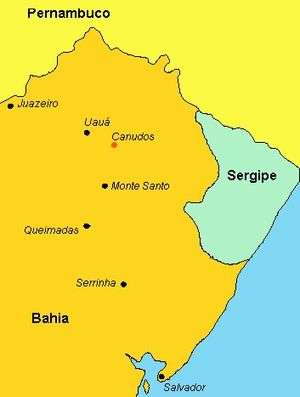 Map of northern Bahia, showing the location of Canudos | |||||||
| |||||||
| Belligerents | |||||||
| Commanders and leaders | |||||||
|
|
| ||||||
| Strength | |||||||
| 12,000 military personnel | 25,000 | ||||||
| Casualties and losses | |||||||
| less than 5,000 dead | almost 25,000 dead; only some 150 survivors | ||||||
Background
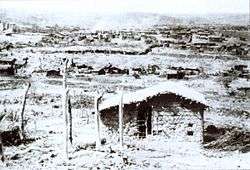
The conflict had its origins in the former settlement of Canudos (named by its inhabitants Belo Monte, meaning "Beautiful Hill" in Portuguese) in the semi-arid backcountry (or Sertão) of Bahia. In the late 19th Century, the region was a desperately poor, with an economy based on subsistence agriculture and cattle raising, severely lacking infrastructure. The disenfranchised population drew equally from rural and urban portions of the region and represented a "broad spectrum of ethnic and economic origins".[3] It was a fertile ground for the growth of dissatisfaction with the newly declared Republic, declared November 15, 1889 after a military coup against the ruling Emperor, Dom Pedro II, who was still beloved by the common people.
This period was characterized by high levels of instability, as the military fought to put down revolts all over the country.[4] It was, therefore, unpopular and dangerous to be branded anything other than Republican during this time.[4] At the onset of this early Republican era, a man by the name of Antônio Vincente Mendes Macial, also known as Antônio Conselheiro (Antônio, the Counselor) began rising to prominence. He was one of the many religious figures that pilgrimed in the backcountry of Brazil.[3] He would move from village to village with his followers, doing errands for the local communities and garnering support from small farmers. As an increasing number of supporters joined his cause, Conselheiro would gain the attention of the local land owners, who disapproved of his ideals.[4]
Conselheiro claimed to be a prophet, and predicted the return of the legendary Portuguese king Sebastian of Portugal (see Sebastianism). He held the belief that "it was the Monarch’s God-given right to rule", which caused him to be progressively branded as a Monarchist figure by the unstable Republic at the time.[3] After wandering through the provinces of Ceará, Pernambuco, Sergipe and Bahia, he would eventually decide to settle permanently in 1893 with his followers in the farming community of Canudos, near Monte Santo, Bahia on the Vaza-Barris River. Within two years, Conselheiro convinced several thousands of followers to join him in his prosperous religious community in the backlands of Bahia,[4] eventually making it the second-largest urban center in Bahia at the time.[3]
Military campaigns
Initial military campaign
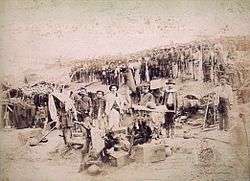
A specific incident was the catalyst for Canudos’ eventual destruction. Conselheiro had placed his usual order of wood from a neighboring business in Joazeiro to construct a new church.[3] However, said order was not delivered, as it seemed that the new local judge, Arlindo Leoni, antagonized Conselheiro and thus prevented the delivery.[3] Some canudenses then took it upon themselves to go to Joazeiro to claim the wood.[3] The judge manipulated the situation by requesting police forces from state governor, Luis Viana, to defend his town against an "invasion" by Conselheiro and his people.[3] Viana recounts that he had been informed by Leoni of "rumors which were current, and which were more or less well-founded, to the effect that the flourishing city in question [Juazeiro] was to be assaulted within a few days by Antônio Conselheiro’s followers."[3]
While the troops were initially dispatched for the sole purpose of preventing assault, Leoni managed to convince their commander Pires Ferreira to march on Canudos.[3] With scant information about terrain and the defensive resources of Canudos' population, a small, 100-man force commanded by Ferreira was sent towards the settlement on November 4, 1896.[5] However, the canudenses marching from the religious settlement to Joazeiro surprised the troops at Uauá and a fierce battle ensued.[3] Estimates of the number of conselheiristas that engaged in the battle varied anywhere from 1,000 to 3,000 men, and accounts report that they were armed with "old muskets, pikes, scythes, long poles, and implements of the land."[3] Despite some considerable losses, estimated at around 150 men, the canudenses defeated the soldiers and drove them off.[3] The troops then retreated to Juazeiro and awaited reinforcements from the state of Bahia.[5]
The government and the media quickly picked up on the soldiers’ loss in the backlands of Bahia. The media played an essential role in escalating the conflict; it spread rumors that the "anti-Republican" settlement was allied with other Monarchists to launch a "Restoration" movement.[4] This increasingly unstable political climate, added to the scarcity of military resources in Bahia, led the provincial government to get national forces involved in order to crush the increasingly threatening settlement.[4] Since the First Brazilian Republic had only recently been founded, it saw the rebel settlers as monarchist separatists, and a bad example and a threat to the new regime.[4]
The President of Brazil at the time, Prudente de Morais, ordered another punitive military expedition to Canudos, and the Brazilian Army began to prepare in November 1896. Facing similar problems that troubled the first expedition, a second 104-man force commanded by Ferreira attacked the settlement on November 21, 1896.[5] It was fiercely defended, however, by a band of 500 armed men, shouting praises to Antonio Conselheiro and the monarchy. The Brazilian soldiers retreated after incurring severe losses and killing around 150 of the settlers, who were armed only with machetes, primitive lances and axes.[5]
Second military campaign
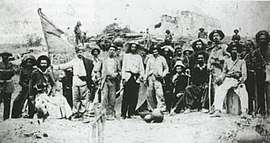
The defeat of the Pires Ferreira campaign and the sensationalist reports about the ferocity and fanaticism of Canudos’ inhabitants provoked an outcry, and calls for reprisals against the village, which continued to grow exponentially, which now numbered over 30,000 residents.[2] On January 12, 1897, the republican troops, which comprised 547 men, 14 officers, and 3 surgeons left Juazeiro for Canudos.[5] Their second clash against the conselheiristas occurred on January 18, and led to the death of 115 canudenses amd minimal losses on the army's side.[3] After some initial success with artillery against the villagers' trenches, however, the soldiers were surrounded by more than 4,000 insurrectionists.[5] Lacking ammunition, food and water, and unable to resist the rebels, who continued to fight despite heavy losses, the soldiers retreated once again to Monte Santo to await reinforcements.[5][3]
What was particularly striking about this expedition was the way in which the canudenses had claimed victory.[3] The fighters completely destroyed areas within a radius of seven miles of Canudos: they burned ranches and farm buildings, creating a ring of scorched earth around the settlement.[3] Amidst a background of journalistic war cries, the canudenses crushing victories led the national military and civilian authorities to label Canudos a serious threat to national order and the prestige of the armed forces and the new government.[3]
Third military campaign
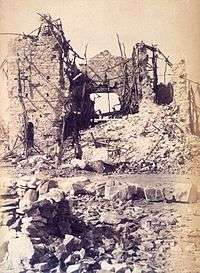
An experienced colonel, Antônio Moreira César, set out with three infantry battalions, one cavalry and one artillery battalion, all newly armed and trained. On February 20, backed with 1,300 troops, Moreira arrived to Monte Santo.[3] A day later, completely disregarding "the intense heat and parched land," a little over a thousand armed men advanced on Canudos.[3] The military forces reportedly carried "seventy rounds of cannon-balls and sixteen million rounds of ammunition."[3]
Although forewarned about the numbers and resolve of the rebels, the military thought it impossible that the rebels would resist such a strong regular army force. However, their equipment quickly turned out be inadequate for the Sertão of Bahia. Wagon trains that carried supplies "sank up to their hubs in sand."[3] The troops nonetheless continued their forced march to Canudos, to which they fired cannon-balls at upon arrival.[3]
However, the bombings had turned the settlement of huts into a "maze" that was impossible for the soldiers to navigate.[3] On March 6, 1897, after only two days of fighting, the surviving officers had no choice but to vote to retreat.[3] Moreira César's protests were overlooked,[3] and he died before dawn due to a fatal wound.[5]
Fourth expedition and final destruction of Canudos
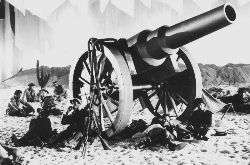
Pressured, the Federal government sent a new expedition under General Arthur Oscar de Andrade Guimarães, and with the direct involvement of the Minister of War, who personally visited Monte Santo, a city near Canudos which served as the gathering point for the large army force being assembled.[5] Machine guns and large artillery pieces, such as mortars and howitzers, including a powerful Whitworth 32 (nicknamed Matadeira (Killer)) went with the 3,000-man force, and had to be hauled with enormous effort through the unforgiving roadless landscape.
The troops set off on June 16.[5] This time, the attackers were aided by the rampant hunger and malnutrition among the inhabitants of Canudos, the rebels' lack of weapons and ammunition, and the heavy losses they had suffered in the previous attacks.[3] The first battalion consisted of 2,350 men, hundreds of whom were trapped by the canudenses and slaughtered.[3] Fearing another failed expedition, the troops retreated to the town of Monte Santo.[3]
The second assault began a month later and involved over 8,000 soldiers.[3] The troops encircled and starved the population of Canudos into submission.[3] The last assault persisted until the beginning of October, when the military forces set off 90 dynamite bombs in the settlement, thus marking the defeat of the people of Canudos.[5] Reports of the fighting state that hundreds of Canudos defenders and federal soldiers died every day.[3]
Throughout this expedition, an undetermined number of canudenses fled the settlement.[3] Those who stayed, however, were fooled into surrendering with the promise of being spared.[3] One of the forces' generals, however, had the men "rounded by soldiers, and hacked to death in front of hundreds of witness, including many of their wives and children."[3] Immediately after the final assault, soldiers "smashed, leveled, and burned all 5,200 in the settlement."[3]
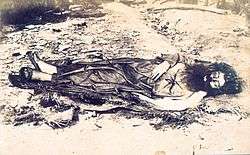
It was eventually determined that Conselheiro had likely died of dysentery on September 22.[3] Before Canudos was burned down and dynamited, Conselheiro's body was exhumed, the head was removed, and it was "displayed on a pike" to be "held high at the front of a military parade for all to see."[3] According to Peter Robb, it "was taken to the Medical Faculty of Bahia to be studied for abnormalities."[6] When all resistance ceased and "peace" was restored, only 150 survivors remained. The more attractive surviving women were reportedly taken captive and sent to brothels in Salvador.
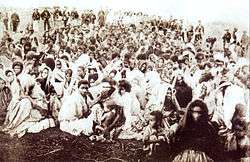
Some authors, such as Euclides da Cunha (1902) estimated the number of deaths in the War of Canudos was ca. 30,000 (25,000 residents and 5,000 attackers)[2] , but some argue that the real number may have been lower (around 15,000).[3] According to Peter Robb, "[t]he foreign correspondents who covered what was soon being called the War of Canudos, as if it were a conflict between nations rather than the extermination of a tiny community within a single country, were nearly all embedded with the army of the Brazilian republic."[6]
Euclides da Cunha did not see the fighting but did bear witness afterward, Robb says, and his "obsession with progress and modernity, the scientific racism that told him the people of the northeastern interior were doomed to backwardness by their mixed race" led him to tell a story filled with preconceptions- which is, however, the only story we have.[6]
Canudos today
Although the original town of Canudos has been covered by the reservoir of the Cocorobó Dam, built by the military regime in the 1960s, the Canudos State Park, established in 1986, preserves many of the important sites and serves as a monument to the war. The stated purpose of the park is to make it impossible to forget the martyrs led by Antônio Conselheiro.[7]
Bibliography
- Calasans, José. No Tempo de Antônio Conselheiro. Salvador, Livraria Progresso Editora, 1959.
- ARINOS, Afonso. Os Jagunços.
- Macedo Soares, Henrique Duque-Estrada de. A Guerra de Canudos.Rio de Janeiro: Typ. Altiva, 1902
- Benício, Manoel. O Rei dos Jagunços. Rio de Janeiro: Editora Fundação Getúlio Vargas. 2a. edição, 1997
Media
- Guerra de Canudos (The Battle of Canudos). Motion picture directed by Sérgio Rezende, with José Wilker, Cláudia Abreu, Paulo Betti, and Marieta Severo. Brazil, 1997. IMDB record
- Sobreviventes – Os Filhos da Guerra de Canudos (Survivors, the Children of the War of Canudos). Documentary film by Paulo Fontenelle, Brazil, 2007.
- Canudos. Documentary film by Ipojuca Pontes, with Walmor Chagas, Brazil, 1978. IMDB record.
- War of Canudos in Brazil. Documentary radio broadcast, BBC World Service. Mon 9 Jun 2014 07:50 GMT. BBC iPlayer
See also
- Revolutions of Brazil
- List of wars involving Brazil
- Landless Workers Movement
- Land reform by country
References
- "Especial - NOTÍCIAS - Uma nova agenda militar". revistaepoca.globo.com. ÉPOCA. Retrieved 21 October 2019.
- Levine, Robert M. (October 1991). "Canudos in the National Context". The Americas. 48 (2): 208. JSTOR 1006824.
- Levine, Robert M. (1992). Vale of Tears: Revisiting the Canudos Massacre in Northeastern Brazil, 1893-1897 (First ed.). University of California Press. pp. 171–177, 184–183, 196, 207.
- Madden, Lori (1993). "The Canudos War in History". Luso-Brazilian Review. 30 (2): 5–22. JSTOR 3513950.
- Cunha, Euclides da (2010). Rebellion in the Backlands. 1957: University of Chicago Press. pp. xxxii–xxxiv. ISBN 978-0143106074.CS1 maint: location (link)
- Robb, Peter (2004). A Death in Brazil (Reprint ed.). Picador. p. 208. ISBN 978-0312424879.
- Neto, Ricardo Bonalume (14 June 1997), "Inaugurado parque estadual de Canudos", Folha de S.Paulo (in Portuguese), retrieved 2016-11-04
External links
| Wikimedia Commons has media related to Guerra de Canudos. |